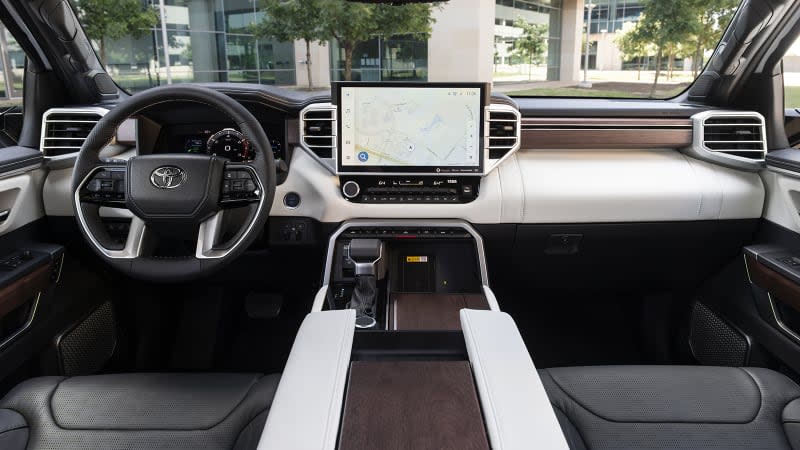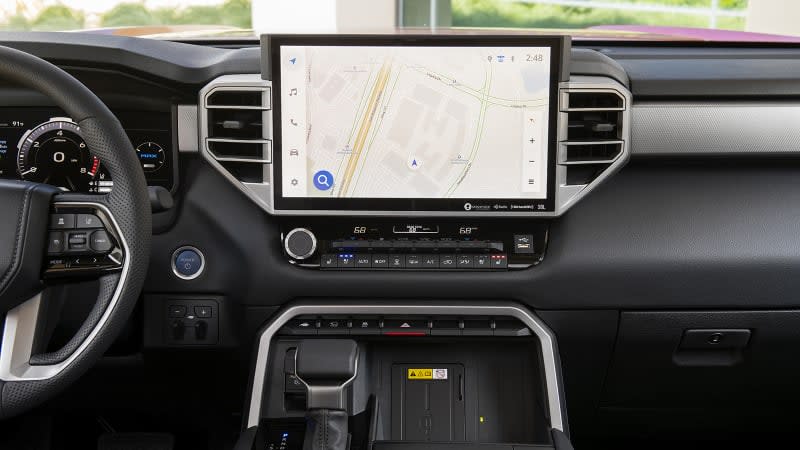2023 Toyota Sequoia Review: Few steps forward, few steps back

Pros: Cool TRD Pro trim level; potential above-average fuel economy; competitive towing capacity
Cons: Poor cargo space; Capstone’s teeth-chattering ride; comparatively cumbersome handling; iffy value
The 2023 Toyota Sequoia represents the first complete redesign of Toyota’s full-size SUV since George W. Bush was president. It should therefore not be surprising that it’s greatly improved in the areas of engine efficiency (it has a twin-turbo hybrid V6), interior quality and technology. The design is certainly more modern, too, while the 2023 Sequoia TRD Pro is an even more capable mountain goat.
Trouble is, the Sequoia has actually fallen backward in key respects. It’s a bit smaller on the outside, which exacerbates the interior packaging issues caused by the hybrid battery and a switch to an old-school solid rear axle versus its predecessors’ independent rear. The result is a cramped third-row seat in a segment where full-size adults should be able to comfortably fit, and a shrunken, extremely compromised cargo area. That solid rear axle does the Sequoia’s handling no favors, either, and when paired with to the Capstone’s enormous 23-inch wheels, results in a teeth-chattering ride that’s quite frankly shocking for something that costs nearly $80,000.
Pricing is another issue. Even though the Sequoia is smaller, less functional and generally less competitive than the Ford Expedition, Jeep Wagoneer and GM’s Tahoe and Yukon siblings, it generally costs more. Maybe it could be argued a hybrid powertrain should come at a premium, but its efficiency advantage is negligible, and we sure weren’t getting close to 20 mpg in our testing. In short, the new Sequoia is not worth the 15-year wait.
Interior & Technology | Passenger & Cargo Space | Performance & Fuel Economy
What it's like to drive | Pricing & Trim Levels | Crash Ratings & Safety Features
What's new for 2023?
The Sequoia is completely redesigned for the first time in more than a decade. You can read more about those changes in our 2023 Toyota Sequoia first drive review.



What are the Sequoia interior and in-car technology like?
The Sequoia shares its cabin design with the Tundra full-size truck. It really doesn’t suffer for that fact in terms of aesthetics, but it perhaps explains why you’ll find a few more hard plastics inside than a Chevy Tahoe or Jeep Wagoneer. Upper trim levels do spruce things up, including the TRD Pro’s unusual red camouflage print seats (below right) or the Capstone’s ritzy combination of open-pore wood trim, black seats and white leatherette interior trim (above, below left).
Standard on most trim levels is an enormous 14-inch touchscreen (the base SR5 gets an 8-inch unit). The operating system is the newest Toyota has to offer, featuring bright, minimalist graphics and natural speech recognition. It's responsive and runs quickly. The shortcut icons on the side closest to the driver are easy to reach, but they unfortunately disappear when you use Apple CarPlay or Android Auto, meaning you have to click-click-click to escape the Apple/Android interfaces rather than using a simple Home button like Toyota used to feature. There are other annoyances we discovered, particularly with the radio operation, that can make the new system less user-friendly than what you’d find in a Tahoe/Yukon, Expedition, Wagoneer and their luxury variants.


How big is the Sequoia?
As a full-size SUV, the Sequoia is obviously enormous on the outside compared to a crossover like the Highlander or even an SUV like the 4Runner. It is smaller than its American full-size SUV competitors on the outside, however, and packaging issues at the rear make it even smaller inside. Quite simply, the Sequoia’s third-row seat and cargo area are not competitive.
While fully grown teens and adults can comfortably fit in the third row of a Tahoe/Yukon, Expedition or Wagoneer, the Sequoia is best suited to those of smaller stature, and even then for shorter trips only. It’s more akin to what you’d find in a three-row crossover, albeit with a higher step-in height. Now, it does uniquely slide fore and aft, but that’s more for the sake of cargo space.
Despite that feature, cargo space is extremely compromised. The biggest issue is that the third row does not fold flat into the floor as its competitors’ do, nor can it be removed. The result is basically a stage for your belongings that requires a significant lift and lean in to reach. With the third-row in use, space shrinks to a degree bested by many large three-row crossovers. And true, you can slide that third row forward to free up extra space, but you’re just shrinking the third row even further and the result still falls short of what you can fit in the American competitors. Toyota at least came up with a clever multi-level cargo floor and partition system, but this largely seems like a workaround for a fundamental flaw.
What are the Sequoia fuel economy and performance specs?
Every Sequoia gets a hybrid powertrain dubbed i-Force Max. It consists of a 3.5-liter twin-turbo V6 and a single electric motor sandwiched between the engine and a 10-speed automatic transmission. It is a fundamentally different design than Toyota’s traditional, efficiency-oriented hybrids. Indeed, while the Sequoia does achieve above-average EPA fuel economy estimates, its performance benefits are the bigger deal: 437 horsepower and 583 pound-feet of torque. Torque in particular betters its gas-powered GM, Ford and Jeep rivals. Its 9,520-pound towing capacity also eclipses them.

 Yahoo Autos
Yahoo Autos 
